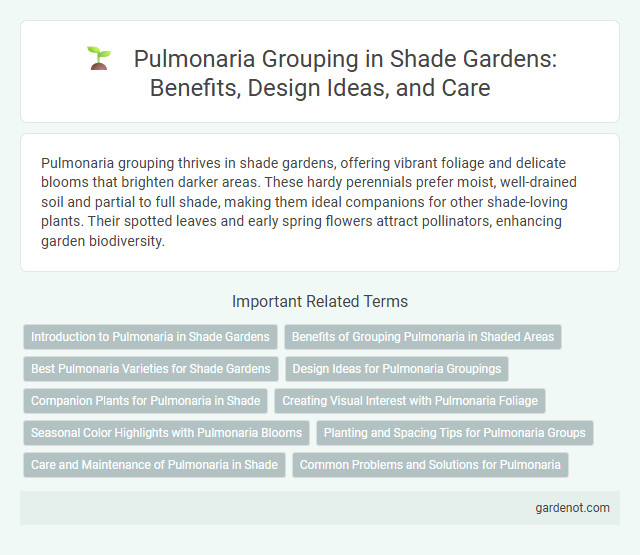Pulmonaria grouping thrives in shade gardens, offering vibrant foliage and delicate blooms that brighten darker areas. These hardy perennials prefer moist, well-drained soil and partial to full shade, making them ideal companions for other shade-loving plants. Their spotted leaves and early spring flowers attract pollinators, enhancing garden biodiversity.
Introduction to Pulmonaria in Shade Gardens
Pulmonaria, commonly known as lungwort, thrives in shade gardens due to its tolerance for low light and preference for moist, well-drained soil. This perennial plant features attractive spotted or mottled foliage that adds texture and color contrast among shade-loving companions like hostas and ferns. Early spring blooms in shades of blue, pink, or white provide vital nectar for pollinators while enhancing garden aesthetics during the transitional season.
Benefits of Grouping Pulmonaria in Shaded Areas
Grouping Pulmonaria in shaded garden areas enhances their vibrant foliage and prolonged blooming period, creating a visually appealing ground cover. These shade-loving perennials improve soil moisture retention and suppress weed growth, contributing to a healthier garden ecosystem. Their clustered growth also attracts pollinators, supporting biodiversity in shaded landscapes.
Best Pulmonaria Varieties for Shade Gardens
Pulmonaria varieties such as Pulmonaria 'Raspberry Splash,' 'Blue Ensign,' and 'Majeste' are ideal for shade gardens due to their vibrant foliage and early spring blooms. These cultivars thrive in moist, well-drained soil with dappled shade, offering a blend of spotted leaves and clusters of tubular flowers in pink, blue, or white. Incorporating these Pulmonaria varieties enhances under-canopy plantings by providing long-lasting color and ground cover that deters weeds.
Design Ideas for Pulmonaria Groupings
Pulmonaria groupings offer rich texture and vibrant early spring color, making them ideal for shaded garden beds. Combine multiple Pulmonaria species with varying leaf patterns and flower hues to create dynamic focal points that thrive under trees or alongside shade-loving perennials like hostas and ferns. Strategic placement near pathways or in woodland gardens enhances visual interest while promoting healthy growth in moist, well-drained soil conditions.
Companion Plants for Pulmonaria in Shade
Pulmonaria thrives in moist, shaded environments and pairs well with companion plants like hostas, ferns, and astilbes that share similar light and soil requirements. These shade-loving plants complement Pulmonaria's spotted foliage and early spring blooms, creating a textured, layered garden aesthetic. Including woodland groundcovers such as Tiarella and Heuchera enhances the natural woodland effect and supports healthy, moisture-retentive soil conditions.
Creating Visual Interest with Pulmonaria Foliage
Pulmonaria grouping enhances shade gardens with its variegated and spotted foliage, creating striking visual interest throughout the growing season. The diverse leaf textures and colors range from deep green to silvery blue, often complemented by vibrant pink or blue spring blossoms. Incorporating clusters of Pulmonaria maximizes ground cover while adding dynamic patterns and contrast against darker shaded areas.
Seasonal Color Highlights with Pulmonaria Blooms
Pulmonaria grouping in shade gardens offers vibrant seasonal color highlights with its early spring blooms of spotted, pink, and blue flowers that attract pollinators. The foliage transforms from reddish bronze in winter to lush green with silver spots in spring, creating year-round visual interest. These perennials thrive in moist, well-drained soil and partial to full shade, making them ideal for under trees and shaded borders.
Planting and Spacing Tips for Pulmonaria Groups
Pulmonaria thrives in shaded garden areas with consistently moist, well-drained soil enriched with organic matter. Space plants about 12 to 18 inches apart to allow for adequate air circulation, reducing the risk of fungal diseases while promoting healthy growth. Grouping Pulmonaria in clusters of three to five enhances their visual impact, creating a dense ground cover that suppresses weeds and maintains soil moisture.
Care and Maintenance of Pulmonaria in Shade
Pulmonaria thrives in consistently moist, well-drained soil enriched with organic matter, making mulching essential to retain moisture and suppress weeds in shade gardens. Regular watering during dry spells prevents leaf scorch, while avoiding overhead watering reduces the risk of fungal diseases such as powdery mildew. Removing spent flowers and trimming back old foliage in early spring promotes healthy new growth and maintains the plant's vibrant variegated leaves.
Common Problems and Solutions for Pulmonaria
Pulmonaria, commonly known as lungwort, often faces common problems such as powdery mildew, leaf spotting, and slug damage in shade gardens. To manage powdery mildew and leaf spot diseases, ensure good air circulation by spacing plants properly and remove affected leaves promptly. Slug damage can be minimized by applying organic slug pellets, using barriers like crushed eggshells, or encouraging natural predators such as birds and frogs.
Pulmonaria grouping Infographic

 gardenot.com
gardenot.com